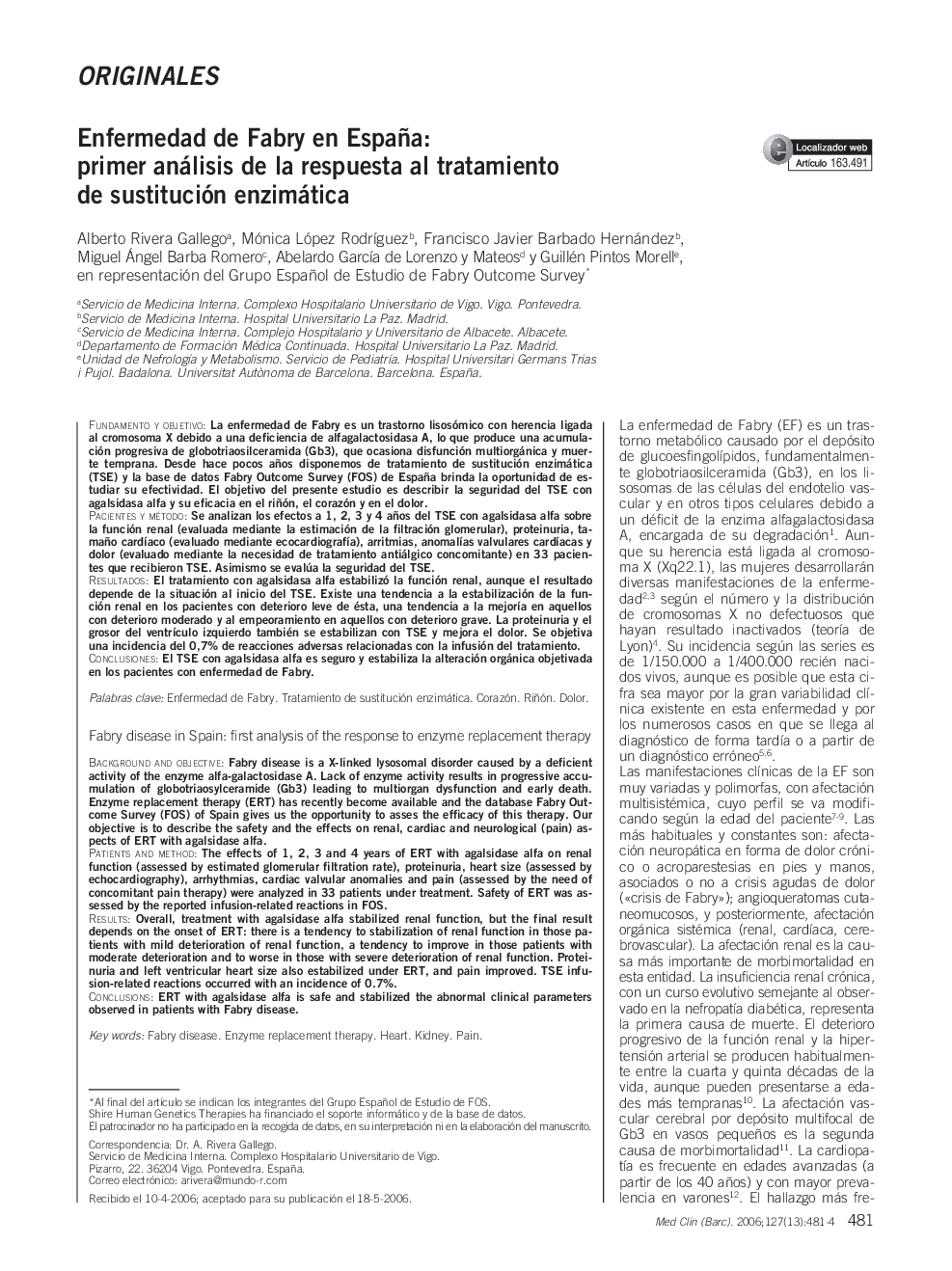| کد مقاله | کد نشریه | سال انتشار | مقاله انگلیسی | نسخه تمام متن |
|---|---|---|---|---|
| 3800169 | 1244620 | 2006 | 4 صفحه PDF | دانلود رایگان |

Fundamento y objetivoLa enfermedad de Fabry es un trastorno lisosómico con herencia ligada al cromosoma X debido a una deficiencia de alfagalactosidasa A, lo que produce una acumulación progresiva de globotriaosilceramida (Gb3), que ocasiona disfunción multiorgánica y muerte temprana. Desde hace pocos años disponemos de tratamiento de sustitución enzimática (TSE) y la base de datos Fabry Outcome Survey (FOS) de España brinda la oportunidad de estudiar su efectividad. El objetivo del presente estudio es describir la seguridad del TSE con agalsidasa alfa y su eficacia en el riñón, el corazón y en el dolor.Pacientes y métodoSe analizan los efectos a 1, 2, 3 y 4 años del TSE con agalsidasa alfa sobre la función renal (evaluada mediante la estimación de la filtración glomerular), proteinuria, tamaño cardÃaco (evaluado mediante ecocardiografÃa), arritmias, anomalÃas valvulares cardÃacas y dolor (evaluado mediante la necesidad de tratamiento antiálgico concomitante) en 33 pacientes que recibieron TSE. Asimismo se evalúa la seguridad del TSE.ResultadosEl tratamiento con agalsidasa alfa estabilizó la función renal, aunque el resultado depende de la situación al inicio del TSE. Existe una tendencia a la estabilización de la función renal en los pacientes con deterioro leve de ésta, una tendencia a la mejorÃa en aquellos con deterioro moderado y al empeoramiento en aquellos con deterioro grave. La proteinuria y el grosor del ventrÃculo izquierdo también se estabilizan con TSE y mejora el dolor. Se objetiva una incidencia del 0,7% de reacciones adversas relacionadas con la infusión del tratamiento.ConclusionesEl TSE con agalsidasa alfa es seguro y estabiliza la alteración orgánica objetivada en los pacientes con enfermedad de Fabry.
Background and objectiveFabry disease is a X-linked lysosomal disorder caused by a deficient activity of the enzyme alfa-galactosidase A. Lack of enzyme activity results in progressive accumulation of globotriaosylceramide (Gb3) leading to multiorgan dysfunction and early death. Enzyme replacement therapy (ERT) has recently become available and the database Fabry Outcome Survey (FOS) of Spain gives us the opportunity to asses the efficacy of this therapy. Our objective is to describe the safety and the effects on renal, cardiac and neurological (pain) aspects of ERT with agalsidase alfa.Patients and methodThe effects of 1, 2, 3 and 4 years of ERT with agalsidase alfa on renal function (assessed by estimated glomerular filtration rate), proteinuria, heart size (assessed by echocardiography), arrhythmias, cardiac valvular anomalies and pain (assessed by the need of concomitant pain therapy) were analyzed in 33 patients under treatment. Safety of ERT was assessed by the reported infusion-related reactions in FOS.ResultsOverall, treatment with agalsidase alfa stabilized renal function, but the final result depends on the onset of ERT: there is a tendency to stabilization of renal function in those patients with mild deterioration of renal function, a tendency to improve in those patients with moderate deterioration and to worse in those with severe deterioration of renal function. Proteinuria and left ventricular heart size also estabilized under ERT, and pain improved. TSE infusion-related reactions occurred with an incidence of 0.7%.ConclusionsERT with agalsidase alfa is safe and stabilized the abnormal clinical parameters observed in patients with Fabry disease.
Journal: Medicina ClÃnica - Volume 127, Issue 13, October 2006, Pages 481-484